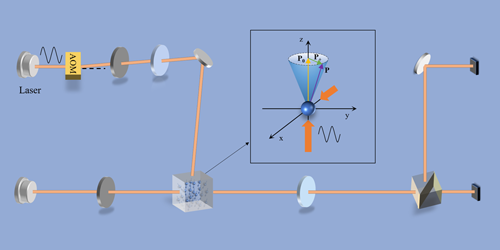“Fictitious” Magnetic Fields for Atomic Magnetometers
Atomic magnetometers have become a more practical alternative to superconducting magnetometers because of their high magnetic-field sensitivity and their less-restrictive temperature requirements. In their simplest configuration, these instruments measure the strength of a magnetic field along a single axis. Dual-axis measurements typically require the generation of an auxiliary magnetic field, which can cause interference in applications where multiple, densely packed magnetometers are required. Now Xiaoyu Li of Beihang University in China and colleagues have demonstrated a dual-axis atomic magnetometer that does not rely on auxiliary magnetic fields [1].
An atomic magnetometer works by orienting the spin axes of an atomic ensemble using a laser (the pump) and then detecting magnetic-field-induced precession of those spins using a second laser (the probe). This configuration is sensitive to the magnetic-field component perpendicular to the pump–probe plane. To detect a second component without introducing another probe beam, an oscillating magnetic field can be applied in the same direction as the pump. This auxiliary field induces an additional harmonic in the signal, proportional to the second magnetic-field component.
Li and colleagues replaced the auxiliary field with an acousto-optic modulator placed in the pump beam. The modulator alters the amplitude of the pump laser at a controlled frequency, creating a “fictitious” magnetic field that reproduces the effect of an oscillating auxiliary field. As a result, the atom spins precess in an additional direction, making them sensitive to a second magnetic-field component.
The all-optical device demonstrated by the researchers achieved sensitivities comparable to conventional dual-axis atomic magnetometers. Next, they say, the device needs to be miniaturized while maintaining its high sensitivity for use in biosensing applications such as magnetoencephalography.
–Martin Rodriguez-Vega
Martin Rodriguez-Vega is an Associate Editor for Physical Review Letters.
References
- X. Li et al., “All-optical dual-axis zero-field atomic magnetometer using light-shift modulation,” Phys. Rev. Appl. 21, 014023 (2024).




